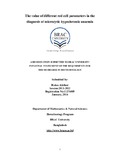The value of different red cell parameters in the diagnosis of microcytic hypochromic anaemia
Abstract
The most common causes of microcytosis are iron deficiency anemia (IDA) and Beta thalassemia trait (BTT). BTT is an important differential diagnosis of IDA in Southeast Asian countries including Bangladesh. A definitive diagnosis of BTT and IDA is based on the result of capillary electrophoresis and serum iron profiles. BTT often shows microcytosis, a normal or an increased red blood cell (RBC) count, and an elevated level of HbA2, which provide the basis for laboratory screening and diagnosis of IDA was made on the basis of decreased ferritin values. The purpose of this study was to explore the use of different red cell parameters with (RET – He) in diagnosis of BTT & IDA. A total of 210 samples were obtained from specimen reception unit of Icddr,b irrespective of sex. Complete blood count was performed to all individuals. Hemoglobin electrophoresis and serum ferritin was performed to samples with MCV less than 80 fl. Prevalence of BTT in this study was 16%, whereas IDA represented 16.6% of total 210 samples investigated. The lowest MCV values were seen in BTT compared with the IDA group. Red blood cell distribution width (RDW-CV) was the highest in IDA group followed by BTT group and then control group. Elevated RBCs count were seen in BTT than in IDA and normal group. A reduction in reticulocyte hemoglobin has been observed in other conditions besides iron deficiency, such as in thalassemia. Microcytosis accompanied by a high RBC count, normal RDW and an elevated level of HbA2 is suggestive of BTT. Microcytosis accompanied by a low ferritin value suggests iron deficiency. Besides measurement of the reticulocyte hemoglobin (RET-He) content is helpful in detecting early stages of iron deficiency prior to the development of anemia.

